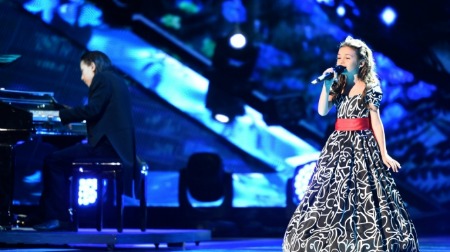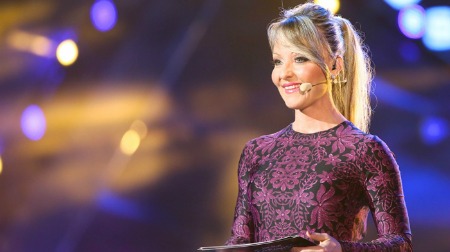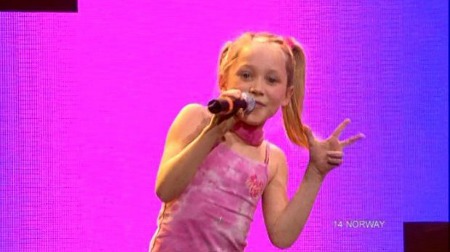The growing interest in the Junior Eurovision Song Contest is tempered somewhat by the perceptions of the first handful of shows from over a decade ago. John Lucas sits down with some VHS tapes to look back at Junior Eurovision 2005 and figure what’s changed, what’s been improved, and why the Contest had to evolve to remain relevant.
The Junior Eurovision Song Contest divides people. Even among the most hardcore Eurovision fans, there are those who follow the November contest as passionately and enthusiastically as the main event in May, and others who decry it as a pale imitation at best and a tasteless embarrassment at worst.
In the past, I’ve tended to fall more into the latter camp. It’s not that I ever had a major objection to the existence of a Junior Contest, I just wasn’t terribly interested in it. I vaguely remember watching the first one back in 2003 and finding it unspeakably naff. The British public evidently agreed, as ratings were poor and two years later we exited the Contest altogether, making it even easier for Junior Eurovision to drop off my radar
Still, over a decade later Junior Eurovision endures and next week, driven by a mix of curiosity and the lure of a cheap off-season holiday, I’ll be joining my fellow ESC Insight writers in Sofia to cover the event. Has the Contest changed for the better since I lost touch with it all those years ago? After all, it took Eurovision itself a good decade before it entered its first golden era of the mid-late sixties.
In order to explore how Junior has evolved, I decided to take advantage of a rainy Sunday afternoon to look at the 2005 and 2014 contests – the former representing the point my home country broke ties with Junior, the latter being probably the best indication of what I can expect to see in Bulgaria.
#Together let’s #Discover the changing face of the Junior Eurovision Song Contest
The Songs
In terms of the number of songs I’d put on my iPod (iPod? John you are so stuck in the last decade) it’s a clear win for 2014. Frankly, there isn’t anything in the 2005 Contest that I’d ever choose to listen to again. The rules for the early contests stated that the children had to compose their own songs, and while I’d question how reliably this could be verified, it does lend to a distinctly ramshackle quality to much of the material.
One thing that quickly becomes obvious is that there’s a world of difference between the musical tastes of an eight year old and a fifteen year old. Watching them competing side-by-side creates a strangely unwieldy playing field even compared to the mishmash of genres and performers we routinely see in the Adult Contest. Young entrants like Norway’s Malin Reitan and Belarusian winner Ksenia Sitnik offer bouncy juvenilia, while several of the older performers approximate the major global pop stars of the era – I’m quickly reminded how popular Avril Lavigne was as the 21st century opened.
These days the rules around who composes the song have been relaxed, meaning the 2014 crop features much more polished productions, several of which wouldn’t sound out of place in the May Contest. As a musical experience, this makes the standard a lot higher, although it does take away a major distinguishing feature of Junior Eurovision as a result.
A side-effect of this change, combined with the introduction of jury voting (again as per the adult Contest) seems to be a sharp increase in the number of ballads performed. There’s only one in the 2005 contest, compared to seven in 2014. Again, as an adult with functioning ears, it’s easier for me to listen to a well-sung, professionally composed ballad than something that sounds like the theme tune to a shrill Nickelodeon cartoon, but I wonder to what extent an eight year old viewer might agree?
The Performers

Bulgaria’s Krisia Todorova was just ten years old, but her song and styling seemed older than her years.
Photo: JuniorEurovision.tv
Judged purely on the standard of the performances, this is another easy win for 2014. In 2005 the youngest performer is just eight years old, and several others are clearly under 12. You might expect the very young performers to be the biggest source of discomfort, but it’s actually the older performers who look self-conscious and out of place. This is brought into sharpest relief in the case of unfortunate UK entrant Joni Fuller.
Accompanying herself on violin, Fuller is clearly a precocious young musician, and when interviewed in the green room she lists the likes of Dire Straits and Kate Bush among her influences. Following a vivacious Romanian flower girl and a Croatian tyke who appears to have arrived dressed as Amelia Earhart, her self-conscious seriousness strikes the wrong tone, not aided by the fact that her rather dirgey entry sounds like the work of a musically gifted child trying very hard to write a ‘grown up’ song, without possessing the experience or gravitas to do so. She’s in the wrong contest here, and a nervous, breathy performance contributes to three of the more awkward minutes of the evening – though the kids in the audience obligingly wave along anyway.
By comparison, while the juvenile performances are vocally shaky and rough around the edges, they all at least seem to be having a really good time. In 2014 the trend is much more towards teenage performers, who are generally a lot more composed and experienced, with more mature, developed voices. Even the youngest performers are generally handling quite middle-aged material. Ten year old Krisia from Bulgaria has a stand-out song and performance, but it does look like she’s playing dress up as an adult diva. In her case it’s a lot easier to watch than poor Joni’s performance because she has a better song and she sings it well, but part of me would rather see the kids just being kids.
The Show
Hosted in the Ethias Arena in Hasselt, Belgium, the 2005 show has a faintly anarchic quality that’s partly in keeping with the hosting of many of the early 00s Eurovisions and partly a reflection of the audience, which primarily consists of excited children and their indulgent parents. Hosts Marcel Vanhilt and Maureen Louys dial up the wacky factor and spend most of their time interacting with the kids in the green room, where the competitors are all in charmingly high spirits with no sign of the nerves that often afflict the adult performers as they wait for the scores to come in.

Malta’s Moira Delia made for a professional if somewhat reserved host of the 2014 Contest.
Photo: JuniorEurovision.tv
The Maltese presentation for 2014 is more professional, with a sole host in the form of Moira Delia, who keeps things moving along smoothly but spends relatively little time with the children themselves. It’s another example of how the Junior seems to have morphed into a closer approximation of its big sister, with a net gain in credibility but losing a little personality in the process. Chalk this one up as a tie.
The Voting
It strikes me while watching 2005 that the performances have been so all over the place I have next to no idea where the votes are going to go. As it turns out, the televoters generally favour the more ‘Junior’ performances, with a victory for Belarus and high placings for Malin from Norway and Danish kid rapper Nicolai. The more teen-friendly performances from Sweden, Malta and the UK languish at the bottom of the scoreboard.
By 2014 the jury element has been introduced and the situation has almost totally reversed. Italy triumph with an old-fashioned romantic ballad, followed by Bulgaria’s emotive ‘Planet of the Children’ and Armenia’s ethnopop flavoured ‘People of the Sun’, both of which could have been adapted to the adult Contest with very little tinkering. Aside from the obligatory ‘everyone’s a winner’ token 12s doled out at the start of the voting, the few unreservedly childish songs from Croatia, Montenegro and San Marino go nowhere.
Conclusion
As the credits roll over a charmingly hyperactive Belarusian reprise, it strikes me that while I have no desire to hear any of the songs from the 2005 Contest ever again, as a piece of entertainment aimed at small children it wasn’t all that bad. It was zippy, energetic and the creepiness factor was frankly much lower than I’d expected going in.
By contrast, I find the standard of the 2014 Contest a lot higher as a music fan, and the show in general a lot easier to watch. As a piece of mass-market television, it’s hard to argue that Junior is a much stronger and more appealing proposition now than it was a decade ago. And yet, I do find myself wondering what the point of it all is. Is Junior supposed to be an experience by kids, for kids, or simply an exercise in brand extension?
If it’s the former, I might actually venture that the 2005 contest was the stronger of the two. It had a lot of problems, but the elements that worked best weren’t even attempting to appeal beyond a pre-teen demographic. It makes me think the show would be better suited to an early afternoon broadcast on a specialty children’s channel, rather than teatime on a major broadcaster.
On the other hand, the sheer scale of the show makes the survival of Junior on the scale it’s at now quite unlikely if it were to be repositioned in this way. The 2014 model of using professional songwriters and encouraging older competitors (the minimum age restriction was shifted 8 to 10 years old in 2007) is undoubtedly healthier for the Junior Eurovision’s continued existence as a relatively major live TV event. There’s a delicate balancing act at play here, and much like the endless tinkering of the format for the adult show, there’ll probably never be a totally perfect solution.
Still, for the time being at least, the Junior Eurovision Song Contest appears to be in rude health, and it certainly isn’t the failed experiment it could so easily have turned out to be. What the show will look like ten years from now is anyone’s guess, but it’s in a strong position and appears to have won over a large proportion of the doubters over the years. S
peaking for myself, unlike the previous decade, I’m actually looking forward to finding out where it goes from here.











